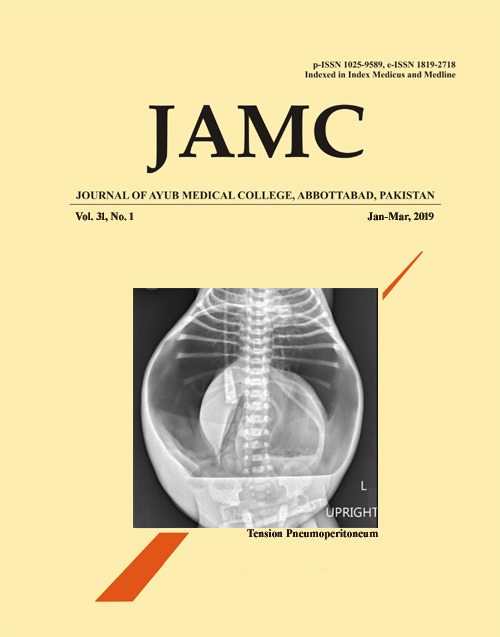ASSOCIATION OF DEGREE OF ST SEGMENT DEPRESSION WITH IN-HOSPITAL MORTALITY IN PATIENTS WITH NON-ST ELEVATION MYOCARDIAL
Abstract
Background: Ischemic heart disease is responsible for approximately 1/3 of all global deaths, making it a leading cause of cardiovascular mortality. Non-ST-segment elevation acute coronary syndrome (NSTE-ACS) which is an acute event in spectrum of coronary artery disease, is a potentially life-threatening emergency, makes up for the majority of admissions to a cardiac unit with one-year mortality rate of 23.5%. The objective of this study was to determine the association of degree of ST segment depression on hospital mortality in patients presenting with Non-ST segment elevation myocardial infarction (NSTEMI). Methods: This descriptive case-series was carried out in the department of Cardiology, Punjab Institute of Cardiology Lahore. Using Non-probability purposive sampling technique, a total of 250 patients of age between 30–75 years of either gender, who reported during the study period, with NSTEMI were inducted in this study. Results: In our study, 33.2% (n=83) patients were between 30-50 years and 66.8% (n=167) patients were between 51–75 years of the age. Mean age was 54.64±9.69 years. 43.2% (n=108) patients were male and 56.8% (n=142) were females. Frequency of in-hospital mortality was 4.4% (n=11). Mortality increased with increasing degree of ST segment depression on admission Electrocardiogram (ECG). Conclusion: In patients admitted with Non-ST segment elevation myocardial infarction (NSTEMI), degree of ST segment depression on admission ECG predicts In-Hospital mortality.Keywords: Non-ST segment elevation myocardial infarction (NSTEMI); ST-segment depression; in-hospital mortalityReferences
Gaziano TA, Gaziano JM. Epidemiology of Cardiovascular Disease. In: Fauci AS, Braunwald E, Kasper DL, Hauser SL, Longo DL, Jameson JL, editors. Harrison Principals of Internal Medicine. 17th ed. Mc-Graw Hills, 2008; p.1377–8.
Abbas S, Kitchlew A, Abbas S. Disease Burden of Ischemic Heart Disease in Pakistan and its Risk Factors. Ann Pak Inst Med Sci 2009;5(3):145–50.
Daga LC, Kaul U, Mansoor A. Approach to STEMI and NSTEMI. J Assoc Physicians India 2011;59:19–25.
Kumar A, Cannon CP. Acute coronary syndromes: Diagnosis and management, part I. Mayo Clin Proc 2009;84(10):917–38.
Gingliano RP, Braunwald E. The Year in non-ST Segment elevation Acute Coronary Syndrome. J Am Coll Cardiol 2009;54(16):1544–55.
Lefebvre CW, Hoekstra J. Approach to non-ST-segment elevation acute coronary syndrome in the emergency department: risk stratification and treatment strategies. Hosp pract 2010;38(2):40–9.
Cristopher P, Braunwald E. Unstable angina and non-ST elevation myocardial infarction. Braunwald's Heart Disease A Textbook of Cardiovascular Medicine. 10th ed. Elsvier Saunders, 2012; p.1178–99.
Tisminetzky M, McManus DD, Erskine N, Saczynski JS, Yarzebski J, Granillo E, et al. Thirty-day hospital readmissions in patients with non-ST-segment elevation acute myocardial infarction. Am J Med 2015;128(7):760–5.
Rogers WJ, Frederick PD, Stoehr E, Canto JG, Ornato JP, Gibson CM, et al. Trends in presenting characteristics and hospital mortality among patients with ST elevation and non-ST elevation myocardial infarction in the National Registry of Myocardial Infarction from 1990 to 2006. Am Heart J 2008;156(6):1026–34.
Darling CE, Fisher KA, McManus DD, Coles AH, Spencer FA, Gore JM, et al. Survival after hospital discharge for ST-segment elevation and non-ST-segment elevation acute myocardial infarction: a population-based study. Clin Epidemiol 2013;5:229–36.
Tan NS, Goodman SG, Yan RT, Elbarouni B, Budaj A, Fox KA, et al. Comparative prognostic value of T-wave inversion and ST-segment depression on the admission electrocardiogram in non-ST-segment elevation acute coronary syndromes. Am Heart J 2013;166(2):290–7.
Westerhout CM, Fu Y, Lauer MS, James S, Armstrong PW, Al-Hattab E, et al. Short- and long-term risk stratification in acute coronary syndromes: the added value of quantitative ST-segment depression and multiple biomarkers. J Am Coll Cardiol 2006;48(5):939–47.
Khan MR, Haq MA, Majumder NK, Hossain MM, Rahman Z, Rahman MT, et al. Extent of ST-Segment Depression Predicts In- Hospital Outcome in Non ST-Segment Elevation Acute Coronary Syndrome. Cardiovasc J 2012;5(1):62–6.
Savonitto S, Cohen MG, Politi A, Hudson MP, Kong DF, Huang Y, et al. Extent of ST-segment depression and cardiac events in non-ST-segment elevation acute coronary syndromes. Eur Heart J 2005;26(20):2106–13.
Nicod P, Giplin E, Dittrich H, Polikar R, Hjalmarson A, Blackey AR, et al. Short and long term clinical outcome after Q wave and non-Q wave myocardial infarction in a large patient population. Circulation 1989;79(3):528¬–36.
Published
Issue
Section
License
Journal of Ayub Medical College, Abbottabad is an OPEN ACCESS JOURNAL which means that all content is FREELY available without charge to all users whether registered with the journal or not. The work published by J Ayub Med Coll Abbottabad is licensed and distributed under the creative commons License CC BY ND Attribution-NoDerivs. Material printed in this journal is OPEN to access, and are FREE for use in academic and research work with proper citation. J Ayub Med Coll Abbottabad accepts only original material for publication with the understanding that except for abstracts, no part of the data has been published or will be submitted for publication elsewhere before appearing in J Ayub Med Coll Abbottabad. The Editorial Board of J Ayub Med Coll Abbottabad makes every effort to ensure the accuracy and authenticity of material printed in J Ayub Med Coll Abbottabad. However, conclusions and statements expressed are views of the authors and do not reflect the opinion/policy of J Ayub Med Coll Abbottabad or the Editorial Board.
USERS are allowed to read, download, copy, distribute, print, search, or link to the full texts of the articles, or use them for any other lawful purpose, without asking prior permission from the publisher or the author. This is in accordance with the BOAI definition of open access.
AUTHORS retain the rights of free downloading/unlimited e-print of full text and sharing/disseminating the article without any restriction, by any means including twitter, scholarly collaboration networks such as ResearchGate, Academia.eu, and social media sites such as Twitter, LinkedIn, Google Scholar and any other professional or academic networking site.









